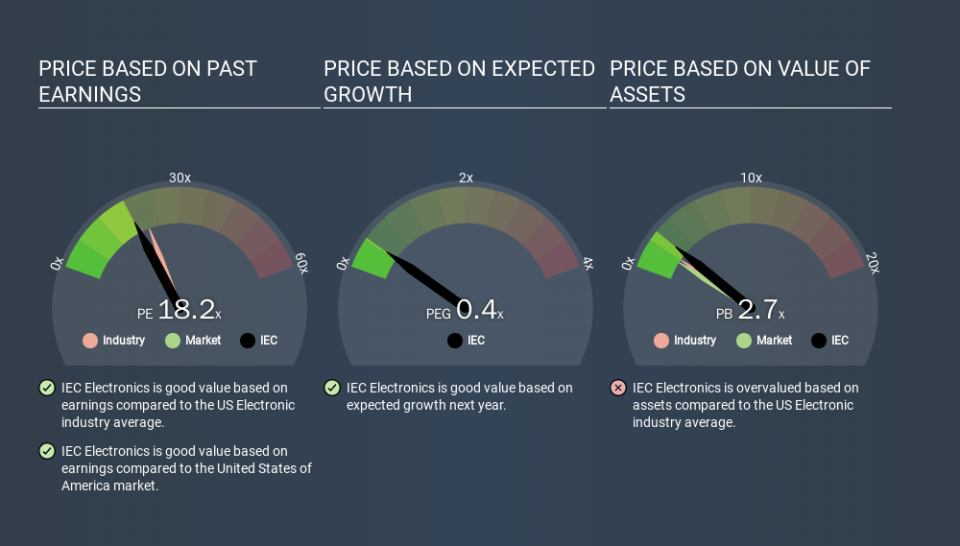Here's How P/E Ratios Can Help Us Understand IEC Electronics Corp. (NYSEMKT:IEC)

Today, we'll introduce the concept of the P/E ratio for those who are learning about investing. We'll look at IEC Electronics Corp.'s (NYSEMKT:IEC) P/E ratio and reflect on what it tells us about the company's share price. Based on the last twelve months, IEC Electronics's P/E ratio is 18.17. That corresponds to an earnings yield of approximately 5.5%.
View our latest analysis for IEC Electronics
How Do You Calculate A P/E Ratio?
The formula for P/E is:
Price to Earnings Ratio = Price per Share ÷ Earnings per Share (EPS)
Or for IEC Electronics:
P/E of 18.17 = $8.30 ÷ $0.46 (Based on the year to September 2019.)
Is A High Price-to-Earnings Ratio Good?
A higher P/E ratio implies that investors pay a higher price for the earning power of the business. That is not a good or a bad thing per se, but a high P/E does imply buyers are optimistic about the future.
How Does IEC Electronics's P/E Ratio Compare To Its Peers?
One good way to get a quick read on what market participants expect of a company is to look at its P/E ratio. The image below shows that IEC Electronics has a lower P/E than the average (21.1) P/E for companies in the electronic industry.
Its relatively low P/E ratio indicates that IEC Electronics shareholders think it will struggle to do as well as other companies in its industry classification. Since the market seems unimpressed with IEC Electronics, it's quite possible it could surprise on the upside. If you consider the stock interesting, further research is recommended. For example, I often monitor director buying and selling.
How Growth Rates Impact P/E Ratios
If earnings fall then in the future the 'E' will be lower. Therefore, even if you pay a low multiple of earnings now, that multiple will become higher in the future. So while a stock may look cheap based on past earnings, it could be expensive based on future earnings.
IEC Electronics saw earnings per share decrease by 55% last year.
Don't Forget: The P/E Does Not Account For Debt or Bank Deposits
Don't forget that the P/E ratio considers market capitalization. In other words, it does not consider any debt or cash that the company may have on the balance sheet. Hypothetically, a company could reduce its future P/E ratio by spending its cash (or taking on debt) to achieve higher earnings.
Such spending might be good or bad, overall, but the key point here is that you need to look at debt to understand the P/E ratio in context.
So What Does IEC Electronics's Balance Sheet Tell Us?
Net debt is 35% of IEC Electronics's market cap. While that's enough to warrant consideration, it doesn't really concern us.
The Bottom Line On IEC Electronics's P/E Ratio
IEC Electronics trades on a P/E ratio of 18.2, which is fairly close to the US market average of 18.5. Given it has some debt, but didn't grow last year, the P/E indicates the market is expecting higher profits ahead for the business.
Investors have an opportunity when market expectations about a stock are wrong. As value investor Benjamin Graham famously said, 'In the short run, the market is a voting machine but in the long run, it is a weighing machine. So this free visualization of the analyst consensus on future earnings could help you make the right decision about whether to buy, sell, or hold.
You might be able to find a better buy than IEC Electronics. If you want a selection of possible winners, check out this free list of interesting companies that trade on a P/E below 20 (but have proven they can grow earnings).
If you spot an error that warrants correction, please contact the editor at editorial-team@simplywallst.com. This article by Simply Wall St is general in nature. It does not constitute a recommendation to buy or sell any stock, and does not take account of your objectives, or your financial situation. Simply Wall St has no position in the stocks mentioned.
We aim to bring you long-term focused research analysis driven by fundamental data. Note that our analysis may not factor in the latest price-sensitive company announcements or qualitative material. Thank you for reading.

